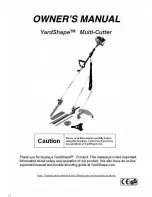
43
Turn on Generator and adjust frequency to 400Hz. Adjust Oscillator amplitude to obtain
50V P/P at amp output. The waveform should be a nice clean sine wave. The amp will
begin to clip at around 57V P/P at the output. If the amp prematurely clips verify that the
input to the amp is not clipped. The amp input can be measured at the junction of C13, R7,
and R6. With 50V P/P at the amp output, there should be around 1.8V P/P at the input to
the amp. If one or more of the above tests fails, proceed to “High and Low Frequency
Power Amp Test”.
If the oscillator is adjusted for 1.8V P/P at pin 1 of U4, the voltage at the input to the filter,
pin 1 of J6, should be about 3.1V P/P. If not, check low frequency filter IC’s (U3A and U4A).
D) Confirmation of High Frequency Chain
Turn on Generator and adjust frequency to 3kHz. Adjust Oscillator amplitude to obtain
50V P/P at amp output. The waveform should be a nice clean sine wave. The amp will
begin to clip at around 58V P/P at the output. If the amp prematurely clips verify that the
input to the amp is not clipped. The amp input can be measured at the junction of R9, R10,
and R11. With 50V P/P at the amp output, there should be around 3.9V P/P at the input to
the amp. If one or more of the above tests fails, proceed to “High and Low Frequency
Power Amp Test”.
If the oscillator is adjusted for 4.9V P/P at pin 7 of U4, the voltage at the input to the filter,
pin 1 of J6, should be about 7.7V P/P. If not, check high frequency filter IC’s (U3B and U4B).
E) Excessive Line Power Test
Verify correct polarity and that none the following parts are not shorted:
C41, C42 (main filters) and D1, D2, Q1, Q2, C9, C14 and BR1 (Main Bridge). Verify that the
+15V and –15V supplies are not shorted. Return to “Main Test Loop” when fault fixed.
Verify that there are no shorts between U1, U2, and their respective heat sinks.
Slowly ramp up input voltage. The voltage at the output pin, of U1, and U2, pin 3, should
be less than +/– 10mV. (Use mV scale). Monitor the temperature of U1, with your finger.
The temperature should warm up slightly but not excessively. The temperature should not
rise more than 10 degrees C after a few minutes of “idle” operation. If any of the above not
true refer to “High Frequency Power Amp Test”.
F) Supply Test
+/– 15V Supply Test
Slowly ramp up Variac, never allowing the supplies to /– 16V. M15V
and –15V supplies. Both should be the correct value +/– .5V.
If a supply is very close to ground potential (Less than +/– 100mV check: for shorts on the
+/–15V supplies; for shorted references D1 or D2; for open devices Q1 and Q2.
If supply is out of specification (deviation of more than .5V but not close to ground poten-
Summary of Contents for EON15
Page 23: ...High Frequency Response EON Power15 and EON15P 1 230 33...
Page 24: ...Low Frequency Response EON Power15 and EON15P 1 230 34...
Page 30: ...Low Frequency Response EON PowerSub 40...
Page 35: ...High Frequency Response EON Power10 45...






































